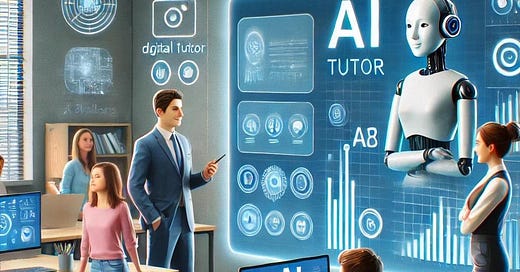Introduction: Welcome to the Future (Ready or Not)
Imagine walking into a classroom where an AI tutor is delivering a history lesson, grading essays in real-time, and suggesting personalized math exercises for each student. Sounds efficient, right? Now, imagine that same AI collecting student data, making subtle decisions that impact academic opportunities, and reinforcing hidden biases. Suddenly, AI in education doesn’t seem like just another shiny tool—it’s a high-stakes balancing act between innovation and ethics.
California school districts are grappling with this reality. AI is here, but the question is: Who’s in control? Without a robust governance framework, schools risk ceding too much power to algorithms while neglecting critical questions of transparency, bias, and student privacy. This essay explores the promise, peril, and policies needed to ensure AI is a force for good in education.
AI in Schools: The Hype vs. The Reality
🤖 The Hype: AI as the Ultimate Teacher’s Assistant
Proponents argue that AI can:
Personalize learning—adapting lessons to student strengths and weaknesses.
Automate grading—freeing teachers from the dreaded stack of essays.
Identify struggling students—providing early interventions before they fall behind.
Enhance accessibility—powering text-to-speech tools and real-time translations.
⚠️ The Reality: An Unchecked AI is an Unfair AI
Without proper oversight, AI in schools can:
Violate student privacy—many AI tools collect massive amounts of personal data without clear policies on usage and retention.
Reinforce biases—algorithms trained on flawed data can amplify inequalities in grading, discipline, and student tracking.
Reduce teacher control—if left unchecked, AI can become the de facto decision-maker on student performance, course recommendations, and even behavioral assessments.
Disadvantage lower-income districts—access to high-quality AI tools varies by funding, exacerbating existing educational gaps.
AI’s Biggest Ethical Challenges in K-12 Education
1. The Surveillance Problem: Who’s Watching the AI?
A Human Rights Watch study found that 89% of educational software used during the pandemic secretly monitored students. If AI monitors student behavior, where does that data go, and who controls it? Schools need clear data protection policies before adopting AI-driven monitoring tools.
2. The Algorithmic Bias Issue: AI Isn’t Always Fair
Bias in AI is not a hypothetical problem—it’s a reality. Studies have shown that:
AI-driven grading systems can undervalue creative and non-traditional responses.
Facial recognition software struggles with accuracy across diverse racial and ethnic groups.
Schools must implement bias audits on AI-powered tools to prevent this and demand vendor transparency.
3. The AI Literacy Gap: Are Teachers and Students Prepared?
Despite AI’s growing role in schools, most teachers and students don’t fully understand how it works. A recent study found that 80% of adults don’t recognize when interacting with AI. This lack of awareness poses serious risks:
Students may blindly trust AI-generated content without questioning accuracy.
Teachers may misuse AI tools without understanding their limitations.
Administrators may adopt AI solutions without considering long-term ethical implications.
AI literacy must become a standard part of digital citizenship education, equipping students and educators with the skills to engage with AI-driven tools critically.
How California School Districts Can Take Control of AI
California school districts must develop proactive governance policies to ensure AI serves students, teachers, and communities—not just vendors and data collectors. Here’s how:
1. Create AI Governance Committees at the District Level
Include educators, students, parents, and AI ethics experts.
Regularly review AI tools for fairness, accuracy, and ethical concerns.
Establish clear accountability guidelines for AI-driven decisions.1
2. Enforce Transparency in AI Usage
Require full disclosure from vendors on how AI tools make decisions.2
Ensure students and parents are informed when AI is used in grading or monitoring.
Develop opt-out policies for AI-driven decisions that affect student outcomes.3
3. Prioritize AI Literacy and Professional Development
Train teachers to effectively integrate AI without sacrificing pedagogical judgment.
Teach students how AI works, where it can fail, and when to question it.
Encourage AI ethics discussions in classrooms to foster critical thinking.
4. Strengthen Data Privacy Protections
Adopt strict student data protection policies limiting AI access to sensitive information.
Demand explicit policies on data retention and deletion from all AI vendors.
Ensure compliance with COPPA, FERPA, and other data protection laws.
Conclusion: AI Should Assist, Not Replace
AI isn’t a substitute for teachers, administrators, or human judgment. Depending on how it’s used, AI can either enhance or undermine the educational experience. Schools must ensure that humans—not algorithms—remain at the center of education.
With strong governance, transparency, and a focus on AI literacy, California school districts can create policies that harness AI’s benefits while protecting students and teachers from risks.
AI is here. The question is: Are we shaping it, or is it shaping us?
Would love to hear your thoughts! How is AI impacting your district? What challenges or successes have you encountered? Let’s discuss! #AIinEducation #EdTech #EducationPolicy
More on this, to come …
Will require legislation from states. Local education agencies just don't have the clout to demand much of anything regarding this stuff.
No, I'm not sure how this would work. But I think it necessary.



